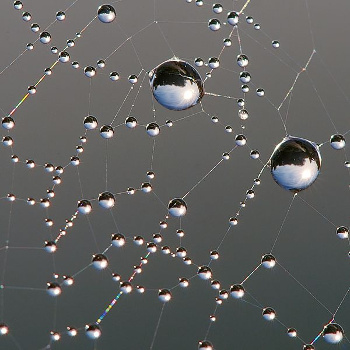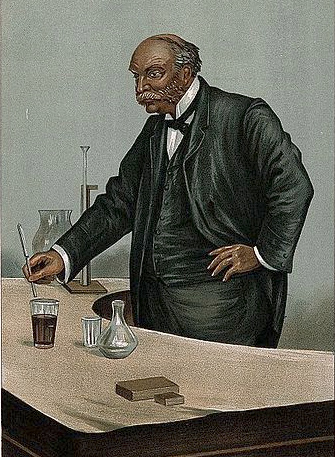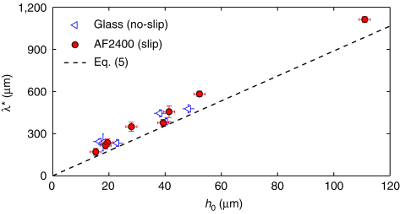Droplet Formation on Fibers
August 6, 2015
There are so many
James Bond films that it's not hard to find a reference in one of them to a specific
science or
technology topic. This article is about
droplets on
fibers; and, yes, there's a
Bond film about that. The film is
You Only Live Twice (1967,
Lewis Gilbert,
Director).[1]
In the film, Bond, played by
Sean Connery goes undercover as a
Japanese fisherman, assisted by a Japanese
secret agent,
Aki, played by
Akiko Wakabayashi. In his typical fashion,
screenwriter,
Roald Dahl, has Aki killed by an
assassin who drips
poison, intended for Bond, down a
thread and into her
mouth. Bond gets his
revenge by
shooting the assassin.

Spider web with dew drops at sunrise.
Even when anchored to these web threads, the surface tension of the water keeps the drops in a spherical shape.
(Photo by Luc Viatour, lucnix.be, via Wikimedia Commons.)
I once
collaborated with a team of
chemists on a project to
coat wires with a unique
ceramic precursor. So, how difficult could this be? Our first approach was to run the wire through a
vat of the
mixture, expecting a nice coating with thickness determined by how fast the wire was pulled. Instead of a uniform layer on the wire, we got a bumpy mess. This was a consequence of a
phenomenon called the
Plateau–Rayleigh instability.
The Plateau–Rayleigh instability is a special case of
Rayleigh–Taylor instability, one of the
scientific legacies of
Lord Rayleigh (1842-1919). Rayleigh and
William Ramsay (1852-1916) were awarded the 1904
Nobel Prize in Chemistry for the discovery of
argon. Among
physicists, Rayleigh is best known for
Rayleigh scattering, the
optical phenomenon that causes the
blue color of the sky.

John William Strutt, 3rd Baron Rayleigh (1842-1919).
An 1899 color lithograph by F. T. Dalton entitled, "Argon," from an issue of Vanity Fair.
(Illustration from Wellcome Images, a website operated by Wellcome Trust, a global charitable foundation based in the United Kingdom, via Wikimedia Commons.)
The Rayleigh–Taylor instability occurs at the
interface between a
dense, and a less-dense,
fluid when the lighter fluid is forced to infiltrate the heavier fluid by an applied
pressure, or through
gravity. One of its physical manifestations is the "fingers" that form when a dense fluid is placed above a less-dense fluid. An example of this instability when lighter and denser
paints are combined can be seen in the references.[2-3]
The Plateau–Rayleigh instability arises from the principle that liquids will minimize their
surface area. That's why droplets are nearly spherical, since that's the way to package the largest
volume in the smallest area. one example of Plateau–Rayleigh instability is the breaking of a continuous stream of water from a
faucet into a stream of droplets. This effect has enabled high speed
inkjet printing, where
vibrations from a
piezoelectric transducer will break a continuous
ink stream into regularly-spaced droplets.
Scientists from
Saarland University (Saarbrücken, Germany),
McMaster University (Hamilton, Ontario, Canada),
PSL Research University (Paris, France), and the
Max Planck Institute for Dynamics and Self-Organization (MPIDS, Göttingen, Germany), have investigated the Plateau–Rayleigh instability in liquid layers on
fibers.[4-5] By observing
lacquer films on glass fibers, the
research team was able to see how the liquid flows along the fiber as a function of the fiber coating.[5]

Two examples of the Plateau–Rayleigh instability of liquids on fibers.
(Photos by H. Haefner, S. Haefner, and A.G. Jacobs of Saarland University.)
Unlike the instability is a free stream of liquid, the instability for liquid layers on fibers requires consideration of the interface between the fiber and the liquid.[4] The research team looked at the
hydrodynamics for
slip and
no-slip conditions at the interface.[4] Says
Oliver Bäumchen from the Max Planck Institute for Dynamics and Self-Organization,
"The contact between the liquid and the fiber is indeed very important... If the liquid slips on the fiber surface, the droplet formation is much faster than in the case of just flow along the fiber".[5]
In
experiments with bare and
Teflon-coated fibers, the liquid film moved rather slowly and droplet formation took longer on the uncoated fibers than on coated fibers. This is because the liquid film was able to slip on the Teflon coating.[5] The
wavelength of the undulations caused by the instability was not sensitive to the solid–liquid interface.[4] The wavelength of the fastest growing
mode was found to be a
linear function of the initial
radius of the fiber plus coating, as shown in the figure.[4]

Linear dependence of wavelength with coated fiber radius.
(Fig. 2 of ref. 4, licensed under a Creative Commons license.)[4)]
Although there was no difference in the
geometry of droplet separation between the coated and uncoated fibers, there was an increased growth rate in the formation of the droplets for the coated fibers.[4] This feature is
technologically important to applications, such as
harvesting water from fog using fiber
nets.[5] I wrote about harvesting water from the air in a
previous article (Fog Water Harvesting, December 2, 2010). This
technology is important for
arid regions of the world, such as
Chile's Atacama Desert.
Conversely, having
homogeneous and stable liquid films on fibers is also important, as my example of wire coating shows. In this case, you would tune your
system to avoid droplet formation. As
Karin Jacobs of Saarland University explains, "The
surface energy of the liquid, its
viscosity, the thickness of the liquid film, as well as the
diameter of the fiber, play an important role."[5]
References:
- You Only Live Twice (1967, Lewis Gilbert, Director) on the Internet Movie Database.
- Art and Physics: Accidental Painting, YouTube Video by Roberto Zenit and Sandra Zetina, National Autonomous University of Mexico, December 7, 2012.
- Sandra Zetina and Roberto Zenit, "Siquieros accidental painting technique: a fluid mechanics point of view," arXiv, October 9, 2012.
- Sabrina Haefner, Michael Benzaquen, Oliver Bäumchen, Thomas Salez, Robert Peters, Joshua D. McGraw, Karin Jacobs, Elie Raphaël, and Kari Dalnoki-Veress, "Influence of slip on the Plateau–Rayleigh instability on a fibre," Nature Communications, vol. 6, article no. 7409 (June 12, 2015), doi:10.1038/ncomms8409. This is an open access paper with a PDF file available here.
- Liquids on fibers -- slipping or flowing? Scientists reveal different dynamics of droplet formation on fibers, Saarland University Press Release, July 1, 2015. Press release in original German.
- Plateau Rayleigh instability englisch, YouTube Video, July 1, 2015.
Permanent Link to this article
Linked Keywords: James Bond; film; science; technology; drop; droplet; fiber; You Only Live Twice; Lewis Gilbert; Director; Sean Connery; Japan; Japanese; fisherman; espionage; secret agent; Aki; Akiko Wakabayashi; screenwriter; Roald Dahl; assassination; assassin; poison; thread; mouth; revenge; gun; shooting; spider web; dew drop; sunrise; surface tension; water; sphere; spherical; Luc Viatour; Wikimedia Commons; collaboration; collaborate; chemist; coating; coat; wire; ceramic; precursor; container; vat; mixture; phenomenon; Plateau–Rayleigh instability; Rayleigh–Taylor instability; science; scientific; Lord Rayleigh (1842-1919); William Ramsay (1852-1916); Nobel Prize in Chemistry; argon; physicist; Rayleigh scattering; optics; optical; blue color of the sky; John William Strutt, 3rd Baron Rayleigh (1842-1919); lithography; lithograph; Vanity Fair; Wellcome Images; Wellcome Trust; interface; density; dense; fluid; pressure; gravitational field; gravity; paint; surface area; volume; faucet; inkjet printing; vibration; piezoelectric transducer; ink; scientist; Saarland University (Saarbrücken, Germany); McMaster University (Hamilton, Ontario, Canada); PSL Research University (Paris, France); Max Planck Institute for Dynamics and Self-Organization (MPIDS, Göttingen, Germany); fiber; lacquer; research; fluid dynamics; hydrodynamics; slip; no-slip condition; Oliver Bäumchen; experiment; polytetrafluoroethylene; Teflon; wavelength; normal mode; linear function; radius; linear dependence; wavelength; Creative Commons license; geometry; technology; technological; fog collection; harvesting water from fog; net; desert climate; arid region; Chile; Atacama Desert; homogeneity; homogeneous; system; Karin Jacobs; surface energy; viscosity; diameter.